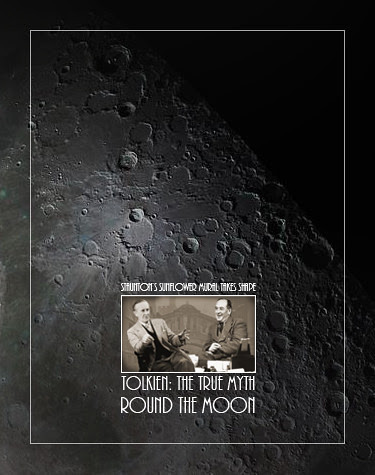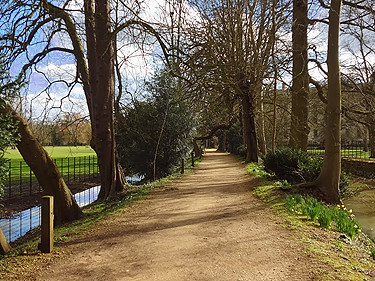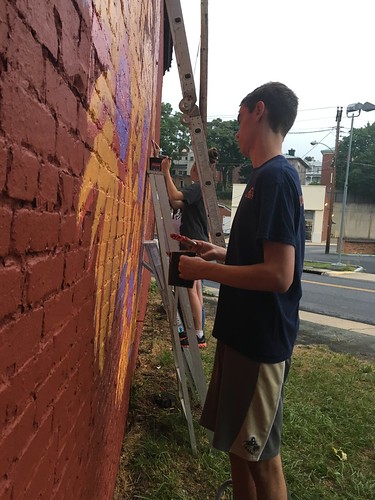
Volume XV, Issue V
J. R. R. Tolkien: The True Myth
[click to read more]
On an early Sunday morning, September 20, 1931, three 30-something English professors took a stroll together on Addison’s Walk in the grounds of Magdalen College at the University of Oxford:
• 32-year-old C. S. Lewis (Fellow and Tutor of English Literature at Magdalen College, Oxford),
• 39-year-old J. R. R. Tolkien (Rawlinson and Bosworth Professor of Anglo-Saxon at Oxford), and
• 35-year-old Hugo Dyson (Tutor and Lecturer at Reading University).
Their time together had begun the evening before at dinner, but their conversation went late into the night.
After Tolkien left around 3 a.m., Lewis and Dyson continued talking until they retired at 4 a.m.
The following Tuesday (September 22), Lewis recounted the scene to his longtime friend and correspondent, Arthur Greeves:
We began on metaphor and myth—interrupted by a rush of wind which came so suddenly on the still, warm evening and sent so many leaves pattering down that we thought it was raining. We all held our breath, the other two appreciating the ecstasy of such a thing almost as you would.
We continued (in my room) on Christianity: a good long satisfying talk in which I learned a lot: then discussed the difference between love and friendship—then finally drifted back to poetry and books.
Later in the letter, discussing the writings of William Morris (a 19th-century English novelist and poet who had greatly influenced Lewis from his youth), Lewis notes:
These hauntingly beautiful lands which somehow never satisfy,—this passion to escape from death plus the certainty that life owes all its charm to mortality—these push you on to the real thing because they fill you with desire and yet prove absolutely clearly that in Morris’s world that desire cannot be satisfied.
The [George] MacDonald conception of death—or, to speak more correctly, St Paul’s—is really the answer to Morris: but I don’t think I should have understood it without going through Morris. He is an unwilling witness to the truth. He shows you just how far you can go without knowing God, and that is far enough to force you . . . to go further.
The following month (October 18), Lewis wrote to Greeves again about their conversation:
Now what Dyson and Tolkien showed me was this: that if I met the idea of sacrifice in a Pagan story I didn’t mind it at all: again, that if I met the idea of a god sacrificing himself to himself . . . I liked it very much and was mysteriously moved by it: again, that the idea of the dying and reviving god (Balder, Adonis, Bacchus) similarly moved me provided I met it anywhere except in the Gospels. The reason was that in Pagan stories I was prepared to feel the myth as profound and suggestive of meanings beyond my grasp even tho’ I could not say in cold prose ‘what it meant’.
Now the story of Christ is simply a true myth: a myth working on us in the same way as the others, but with this tremendous difference that it really happened.
Years later Lewis wrote a poem entitled “What the Bird Said Early in the Year,” which not coincidentally is set in Addison’s Walk, and has to do with a spell becoming undone.

I heard in Addison’s Walk a bird sing clear:
This year the summer will come true. This year. This year.
Winds will not strip the blossom from the apple trees
This year, nor want of rain destroy the peas.
This year time’s nature will no more defeat you,
Nor all the promised moments in their passing cheat you.
This time they will not lead you round and back
To Autumn, one year older, by the well-worn track.
This year, this year, as all these flowers foretell,
We shall escape the circle and undo the spell.
Often deceived, yet open once again your heart,
Quick, quick, quick, quick!—the gates are drawn apart.
Let him who has ears to hear, hear.
Postscript
Some readers might wonder about the relationship between this event and Lewis’s conversion to theism, and then his actual conversion to Christianity.
Conversion to Theism
In his 1955 memoir, Surprised by Joy, Lewis famously tells his readers that he finally abandoned his resistance to God, becoming “the most dejected and reluctant convert in all England,” in the Trinity Term (the eight weeks from late April to late June) in 1929.
That dating would seem to settle the matter. And it did for virtually all Lewis scholars, until Alister McGrath was researching the question for his 2013 biography, C. S. Lewis—A Life: Eccentric Genius, Reluctant Prophet. In short, McGrath believes that Lewis was off by one year in his recollection, and that it was actually Trinity Term of 1930 (possibly in mid–June). If McGrath is correct, then the conversation with Tolkien (September 1931) was a little more than a year after Lewis began to believe in God (June 1930).
McGrath came to this conclusion for four reasons:
First, . . . a close and continuous reading of his works—especially his correspondence—reveals no sign of a significant change in tone or mood throughout 1929, and even in early 1930. Between September 1925 and January 1930, Lewis’s writings disclose no hint of any radical change of heart or mind, or even a pending change. If Lewis was converted in 1929, this supposedly pivotal event seems to have made no impact on his writings—including his letters to his closest friends at that time, Owen Barfield and Arthur Greeves.
Second, Lewis’s widowed father died in September 1929. If Lewis’s chronology of his own conversion is accepted, Lewis had come to believe in God at the time of his father’s death. Yet Lewis’s correspondence makes no reference at all to any impact of a belief in God, however emergent, upon his final days spent with his father, his subsequent funeral, and its emotional aftermath. Might, I wondered, the death of Lewis’s father have been a stimulus to him to think about God, rather than something he approached from an existing theistic perspective? If Lewis discovered God in the summer of 1930, his father’s death the previous year might well have marked a turning point in his thinking.
Third, Lewis’s account of the dynamics of his conversion in Surprised by Joy speaks of God closing in on him, taking the initiative, and ultimately overwhelming him. We find echoes of this language in a short letter from Lewis to Owen Barfield, written hastily on 3 February 1930, which speaks of the “spirit” becoming “much more personal,” “taking the offensive” and “behaving just like God.” Lewis asked Barfield to come and see him soon, before he made a rash decision to “enter a monastery.” Barfield was later unequivocal about the significance of this letter for Lewis’s spiritual development: it marked “the beginning of his conversion.” The letter reflects Lewis’s language about the pressures he experienced immediately before his conversion. Yet this conversion is clearly ahead of him, not behind him.
Fourth, Lewis makes it clear that his behaviour changed as a result of his new belief in God. Although still not committed to Christianity, he now began to attend both his local parish church on Sundays, and college chapel on weekdays. Yet Lewis’s correspondence makes no reference to regular attendance at any Oxford church or Magdalen College chapel in 1929, or the first half of 1930. Yet things change decisively in October 1930. In a letter to his close friend and confidant Arthur Greeves, dated 29 October 1930, Lewis mentions that he now goes to bed earlier than he used, to, as he has now “started going to morning chapel at 8.” This is presented as a new development, a significant change in his routine, dating from the beginning of the academic year 1930–1. The date of this change of habit makes sense if Lewis discovered God in the summer of 1930—perhaps in June 1930, right at the end of the academic year. This would explain Lewis starting to attend college chapel in October 1930. The Oxford academic year resumes in October, thus giving Lewis the opportunity to begin attending college chapel regularly.
McGrath further notes that Lewis was “unreliable when it comes to relating his internal and external world.”
When it comes to dates, months, and days, Lewis gets things muddled. Lewis himself remarked on this failing in 1957, shortly after the publication of Surprised by Joy: he could now, he confessed, “never remember dates.” His older brother Warnie declared that Lewis had a “life-long inability to keep track of dates.” When Lewis became Vice-President of Magdalen College, Oxford in 1941—a fixed-term appointment with essentially administrative responsibilities, which rotated around the fellowship—he was soon found to be incapable of carrying out one of the chief responsibilities of this role: arranging for the booking of rooms for college meetings or private engagements. Lewis simply could not remember dates. Rooms were double-booked—if they were booked at all.
Conversion to Christianity
On September 28, 1931—just nine days after Lewis’s conversation with Tolkien on Christ being the true myth—Lewis took the final step in embracing the divinity of Christ while riding in his older brother’s motorcycle sidecar on the way to the newly opened Whipsnade Park Zoo in Bedfordshire. He recounts:
I know very well when, but not how, the final step was taken.
I was driven to Whipsnade one sunny morning. When we set out I did not believe that Jesus Christ is the Son of God, and when we reached the zoo I did.
Yet I had not exactly spent the journey in thought. (read more)
Round the Moon
By Jules Verne
CHAPTER XI, FANCY AND REALITY
Have you ever seen the moon?" asked a professor, ironically, of one of his pupils.
No, sir!" replied the pupil, still more ironically, "but I must say I have heard it spoken of."
In one sense, the pupil's witty answer might be given by a large majority of sublunary beings. How many people have heard speak of the moon who have never seen it-- at least through a glass or a telescope! How many have never examined the map of their satellite!
In looking at a selenographic map, one peculiarity strikes us. Contrary to the arrangement followed for that of the Earth and Mars, the continents occupy more particularly the southern hemisphere of the lunar globe. These continents do not show such decided, clear, and regular boundary lines as South America, Africa, and the Indian peninsula. Their angular, capricious, and deeply indented coasts are rich in gulfs and peninsulas. They remind one of the confusion in the islands of the Sound, where the land is excessively indented. If navigation ever existed on the surface of the moon, it must have been wonderfully difficult and dangerous; and we may well pity the Selenite sailors and hydrographers; the former, when they came upon these perilous coasts, the latter when they took the soundings of its stormy banks.
We may also notice that, on the lunar sphere, the south pole is much more continental than the north pole. On the latter, there is but one slight strip of land separated from other continents by vast seas. Toward the south, continents clothe almost the whole of the hemisphere. It is even possible that the Selenites have already planted the flag on one of their poles, while Franklin, Ross, Kane, Dumont, d'Urville, and Lambert have never yet been able to attain that unknown point of the terrestrial globe.
As to islands, they are numerous on the surface of the moon. Nearly all oblong or circular, and as if traced with the compass, they seem to form one vast archipelago, equal to that charming group lying between Greece and Asia Minor, and which mythology in ancient times adorned with most graceful legends. Involuntarily the names of Naxos, Tenedos, and Carpathos, rise before the mind, and we seek vainly for Ulysses' vessel or the "clipper" of the Argonauts. So at least it was in Michel Ardan's eyes. To him it was a Grecian archipelago that he saw on the map. To the eyes of his matter-of-fact companions, the aspect of these coasts recalled rather the parceled-out land of New Brunswick and Nova Scotia, and where the Frenchman discovered traces of the heroes of fable, these Americans were marking the most favorable points for the establishment of stores in the interests of lunar commerce and industry.
After wandering over these vast continents, the eye is attracted by the still greater seas. Not only their formation, but their situation and aspect remind one of the terrestrial oceans; but again, as on earth, these seas occupy the greater portion of the globe. But in point of fact, these are not liquid spaces, but plains, the nature of which the travelers hoped soon to determine. Astronomers, we must allow, have graced these pretended seas with at least odd names, which science has respected up to the present time. Michel Ardan was right when he compared this map to a "Tendre card," got up by a Scudary or a Cyrano de Bergerac. "Only," said he, "it is no longer the sentimental card of the seventeenth century, it is the card of life, very neatly divided into two parts, one feminine, the other masculine; the right hemisphere for woman, the left for man."
In speaking thus, Michel made his prosaic companions shrug their shoulders. Barbicane and Nicholl looked upon the lunar map from a very different point of view to that of their fantastic friend. Nevertheless, their fantastic friend was a little in the right. Judge for yourselves.
In the left hemisphere stretches the "Sea of Clouds," where human reason is so often shipwrecked. Not far off lies the "Sea of Rains," fed by all the fever of existence. Near this is the "Sea of Storms," where man is ever fighting against his passions, which too often gain the victory. Then, worn out by deceit, treasons, infidelity, and the whole body of terrestrial misery, what does he find at the end of his career? that vast "Sea of Humors," barely softened by some drops of the waters from the "Gulf of Dew!" Clouds, rain, storms, and humors-- does the life of man contain aught but these? and is it not summed up in these four words?
The right hemisphere, "dedicated to the ladies," encloses smaller seas, whose significant names contain every incident of a feminine existence. There is the "Sea of Serenity," over which the young girl bends; "The Lake of Dreams," reflecting a joyous future; "The Sea of Nectar," with its waves of tenderness and breezes of love; "The Sea of Fruitfulness;" "The Sea of Crises;" then the "Sea of Vapors," whose dimensions are perhaps a little too confined; and lastly, that vast "Sea of Tranquillity," in which every false passion, every useless dream, every unsatisfied desire is at length absorbed, and whose waves emerge peacefully into the "Lake of Death!" What a strange succession of names! What a singular division of the moon's two hemispheres, joined to one another like man and woman, and forming that sphere of life carried into space! And was not the fantastic Michel right in thus interpreting the fancies of the ancient astronomers? But while his imagination thus roved over "the seas," his grave companions were considering things more geographically.
They were learning this new world by heart. They were measuring angles and diameters.
CHAPTER XII, OROGRAPHIC DETAILS
The course taken by the projectile, as we have before remarked, was bearing it toward the moon's northern hemisphere. The travelers were far from the central point which they would have struck, had their course not been subject to an irremediable deviation. It was past midnight; and Barbicane then estimated the distance at seven hundred and fifty miles, which was a little greater than the length of the lunar radius, and which would diminish as it advanced nearer to the North Pole. The projectile was then not at the altitude of the equator; but across the tenth parallel, and from that latitude, carefully taken on the map to the pole, Barbicane and his two companions were able to observe the moon under the most favorable conditions. Indeed, by means of glasses, the above-named distance was reduced to little more than fourteen miles. The telescope of the Rocky Mountains brought the moon much nearer; but the terrestrial atmosphere singularly lessened its power. Thus Barbicane, posted in his projectile, with the glasses to his eyes, could seize upon details which were almost imperceptible to earthly observers.
My friends," said the president, in a serious voice, "I do not know whither we are going; I do not know if we shall ever see the terrestrial globe again. Nevertheless, let us proceed as if our work would one day by useful to our fellow-men. Let us keep our minds free from every other consideration. We are astronomers; and this projectile is a room in the Cambridge University, carried into space. Let us make our observations!"
This said, work was begun with great exactness; and they faithfully reproduced the different aspects of the moon, at the different distances which the projectile reached.
At the time that the projectile was as high as the tenth parallel, north latitude, it seemed rigidly to follow the twentieth degree, east longitude. We must here make one important remark with regard to the map by which they were taking observations. In the selenographical maps where, on account of the reversing of the objects by the glasses, the south is above and the north below, it would seem natural that, on account of that inversion, the east should be to the left hand, and the west to the right. But it is not so. If the map were turned upside down, showing the moon as we see her, the east would be to the left, and the west to the right, contrary to that which exists on terrestrial maps. The following is the reason of this anomaly. Observers in the northern hemisphere (say in Europe) see the moon in the south-- according to them. When they take observations, they turn their backs to the north, the reverse position to that which they occupy when they study a terrestrial map. As they turn their backs to the north, the east is on their left, and the west to their right. To observers in the southern hemisphere (Patagonia for example), the moon's west would be quite to their left, and the east to their right, as the south is behind them. Such is the reason of the apparent reversing of these two cardinal points, and we must bear it in mind in order to be able to follow President Barbicane's observations.
With the help of Boeer and Moedler's Mappa Selenographica, the travelers were able at once to recognize that portion of the disc enclosed within the field of their glasses.
What are we looking at, at this moment?" asked Michel.
At the northern part of the `Sea of Clouds,'" answered Barbicane. "We are too far off to recognize its nature. Are these plains composed of arid sand, as the first astronomer maintained? Or are they nothing but immense forests, according to M. Warren de la Rue's opinion, who gives the moon an atmosphere, though a very low and a very dense one? That we shall know by and by. We must affirm nothing until we are in a position to do so."
This "Sea of Clouds" is rather doubtfully marked out upon the maps. It is supposed that these vast plains are strewn with blocks of lava from the neighboring volcanoes on its right, Ptolemy, Purbach, Arzachel.
But the projectile was advancing, and sensibly nearing it. Soon there appeared the heights which bound this sea at this northern limit. Before them rose a mountain radiant with beauty, the top of which seemed lost in an eruption of solar rays.
That is--?" asked Michel.
Copernicus," replied Barbicane.
Let us see Copernicus."
This mount, situated in 9@ north latitude and 20@ east longitude, rose to a height of 10,600 feet above the surface of the moon. It is quite visible from the earth; and astronomers can study it with ease, particularly during the phase between the last quarter and the new moon, because then the shadows are thrown lengthways from east to west, allowing them to measure the heights.
This Copernicus forms the most important of the radiating system, situated in the southern hemisphere, according to Tycho Brahe. It rises isolated like a gigantic lighthouse on that portion of the "Sea of Clouds," which is bounded by the "Sea of Tempests," thus lighting by its splendid rays two oceans at a time. It was a sight without an equal, those long luminous trains, so dazzling in the full moon, and which, passing the boundary chain on the north, extends to the "Sea of Rains." At one o'clock of the terrestrial morning, the projectile, like a balloon borne into space, overlooked the top of this superb mount. Barbicane could recognize perfectly its chief features. Copernicus is comprised in the series of ringed mountains of the first order, in the division of great circles. Like Kepler and Aristarchus, which overlook the "Ocean of Tempests," sometimes it appeared like a brilliant point through the cloudy light, and was taken for a volcano in activity. But it is only an extinct one-- like all on that side of the moon. Its circumference showed a diameter of about twenty-two leagues. The glasses discovered traces of stratification produced by successive eruptions, and the neighborhood was strewn with volcanic remains which still choked some of the craters.
There exist," said Barbicane, "several kinds of circles on the surface of the moon, and it is easy to see that Copernicus belongs to the radiating class. If we were nearer, we should see the cones bristling on the inside, which in former times were so many fiery mouths. A curious arrangement, and one without an exception on the lunar disc, is that the interior surface of these circles is the reverse of the exterior, and contrary to the form taken by terrestrial craters. It follows, then, that the general curve of the bottom of these circles gives a sphere of a smaller diameter than that of the moon."
And why this peculiar disposition?" asked Nicholl.
We do not know," replied Barbicane.
What splendid radiation!" said Michel. "One could hardly see a finer spectacle, I think."
What would you say, then," replied Barbicane, "if chance should bear us toward the southern hemisphere?"
Well, I should say that it was still more beautiful," retorted Michel Ardan.
At this moment the projectile hung perpendicularly over the circle. The circumference of Copernicus formed almost a perfect circle, and its steep escarpments were clearly defined. They could even distinguish a second ringed enclosure. Around spread a grayish plain, of a wild aspect, on which every relief was marked in yellow. At the bottom of the circle, as if enclosed in a jewel case, sparkled for one instant two or three eruptive cones, like enormous dazzling gems. Toward the north the escarpments were lowered by a depression which would probably have given access to the interior of the crater.
In passing over the surrounding plains, Barbicane noticed a great number of less important mountains; and among others a little ringed one called Guy Lussac, the breadth of which measured twelve miles.
Toward the south, the plain was very flat, without one elevation, without one projection. Toward the north, on the contrary, till where it was bounded by the "Sea of Storms," it resembled a liquid surface agitated by a storm, of which the hills and hollows formed a succession of waves suddenly congealed. Over the whole of this, and in all directions, lay the luminous lines, all converging to the summit of Copernicus.
The travelers discussed the origin of these strange rays; but they could not determine their nature any more than terrestrial observers.
But why," said Nicholl, "should not these rays be simply spurs of mountains which reflect more vividly the light of the sun?"
No," replied Barbicane; "if it was so, under certain conditions of the moon, these ridges would cast shadows, and they do not cast any."
And indeed, these rays only appeared when the orb of day was in opposition to the moon, and disappeared as soon as its rays became oblique.
But how have they endeavored to explain these lines of light?" asked Michel; "for I cannot believe that savants would ever be stranded for want of an explanation."
Yes," replied Barbicane; "Herschel has put forward an opinion, but he did not venture to affirm it."
Never mind. What was the opinion?"
He thought that these rays might be streams of cooled lava which shone when the sun beat straight upon them. It may be so; but nothing can be less certain. Besides, if we pass nearer to Tycho, we shall be in a better position to find out the cause of this radiation."
Do you know, my friends, what that plain, seen from the height we are at, resembles?" said Michel.
No," replied Nicholl.
Very well; with all those pieces of lava lengthened like rockets, it resembles an immense game of spelikans thrown pellmell. There wants but the hook to pull them out one by one."
Do be serious," said Barbicane.
Well, let us be serious," replied Michel quietly; "and instead of spelikans, let us put bones. This plain, would then be nothing but an immense cemetery, on which would repose the mortal remains of thousands of extinct generations. Do you prefer that high-flown comparison?"
One is as good as the other," retorted Barbicane.
My word, you are difficult to please," answered Michel.
My worthy friend," continued the matter-of-fact Barbicane, "it matters but little what it resembles, when we do not know what it is."
Well answered," exclaimed Michel. "That will teach me to reason with savants."
But the projectile continued to advance with almost uniform speed around the lunar disc. The travelers, we may easily imagine, did not dream of taking a moment's rest. Every minute changed the landscape which fled from beneath their gaze. About half past one o'clock in the morning, they caught a glimpse of the tops of another mountain. Barbicane, consulting his map, recognized Eratosthenes.
It was a ringed mountain nine thousand feet high, and one of those circles so numerous on this satellite. With regard to this, Barbicane related Kepler's singular opinion on the formation of circles. According to that celebrated mathematician, these crater-like cavities had been dug by the hand of man.
For what purpose?" asked Nicholl.
For a very natural one," replied Barbicane. "The Selenites might have undertaken these immense works and dug these enormous holes for a refuge and shield from the solar rays which beat upon them during fifteen consecutive days." "The Selenites are not fools," said Michel.
A singular idea," replied Nicholl; "but it is probable that Kepler did not know the true dimensions of these circles, for the digging of them would have been the work of giants quite impossible for the Selenites."
Why? if weight on the moon's surface is six times less than on the earth?" said Michel.
But if the Selenites are six times smaller?" retorted Nicholl.
And if there are no Selenites?" added Barbicane.
This put an end to the discussion.
Soon Eratosthenes disappeared under the horizon without the projectile being sufficiently near to allow close observation. This mountain separated the Apennines from the Carpathians. In the lunar orography they have discerned some chains of mountains, which are chiefly distributed over the northern hemisphere. Some, however, occupy certain portions of the southern hemisphere also.
About two o'clock in the morning Barbicane found that they were above the twentieth lunar parallel.
The distance of the projectile from the moon was not more than six hundred miles. Barbicane, now perceiving that the projectile was steadily approaching the lunar disc, did not despair; if not of reaching her, at least of discovering the secrets of her configuration.
CHAPTER XIII, LUNAR LANDSCAPES
At half-past two in the morning, the projectile was over the thirteenth lunar parallel and at the effective distance of five hundred miles, reduced by the glasses to five. It still seemed impossible, however, that it could ever touch any part of the disc. Its motive speed, comparatively so moderate, was inexplicable to President Barbicane. At that distance from the moon it must have been considerable, to enable it to bear up against her attraction. Here was a phenomenon the cause of which escaped them again. Besides, time failed them to investigate the cause. All lunar relief was defiling under the eyes of the travelers, and they would not lose a single detail.
Under the glasses the disc appeared at the distance of five miles. What would an aeronaut, borne to this distance from the earth, distinguish on its surface? We cannot say, since the greatest ascension has not been more than 25,000 feet.
This, however, is an exact description of what Barbicane and his companions saw at this height. Large patches of different colors appeared on the disc. Selenographers are not agreed upon the nature of these colors. There are several, and rather vividly marked. Julius Schmidt pretends that, if the terrestrial oceans were dried up, a Selenite observer could not distinguish on the globe a greater diversity of shades between the oceans and the continental plains than those on the moon present to a terrestrial observer. According to him, the color common to the vast plains known by the name of "seas" is a dark gray mixed with green and brown. Some of the large craters present the same appearance. Barbicane knew this opinion of the German selenographer, an opinion shared by Boeer and Moedler. Observation has proved that right was on their side, and not on that of some astronomers who admit the existence of only gray on the moon's surface. In some parts green was very distinct, such as springs, according to Julius Schmidt, from the seas of "Serenity and Humors." Barbicane also noticed large craters, without any interior cones, which shed a bluish tint similar to the reflection of a sheet of steel freshly polished. These colors belonged really to the lunar disc, and did not result, as some astronomers say, either from the imperfection in the objective of the glasses or from the interposition of the terrestrial atmosphere.
Not a doubt existed in Barbicane's mind with regard to it, as he observed it through space, and so could not commit any optical error. He considered the establishment of this fact as an acquisition to science. Now, were these shades of green, belonging to tropical vegetation, kept up by a low dense atmosphere? He could not yet say.
Farther on, he noticed a reddish tint, quite defined. The same shade had before been observed at the bottom of an isolated enclosure, known by the name of Lichtenburg's circle, which is situated near the Hercynian mountains, on the borders of the moon; but they could not tell the nature of it.
They were not more fortunate with regard to another peculiarity of the disc, for they could not decide upon the cause of it.
Michel Ardan was watching near the president, when he noticed long white lines, vividly lighted up by the direct rays of the sun. It was a succession of luminous furrows, very different from the radiation of Copernicus not long before; they ran parallel with each other.
Michel, with his usual readiness, hastened to exclaim:
Look there! cultivated fields!"
Cultivated fields!" replied Nicholl, shrugging his shoulders.
Plowed, at all events," retorted Michel Ardan; "but what laborers those Selenites must be, and what giant oxen they must harness to their plow to cut such furrows!"
They are not furrows," said Barbicane; "they are rifts."
Rifts? stuff!" replied Michel mildly; "but what do you mean by `rifts' in the scientific world?"
Barbicane immediately enlightened his companion as to what he knew about lunar rifts.
He knew that they were a kind of furrow found on every part of the disc which was not mountainous; that these furrows, generally isolated, measured from 400 to 500 leagues in length; that their breadth varied from 1,000 to 1,500 yards, and that their borders were strictly parallel; but he knew nothing more either of their formation or their nature.
Barbicane, through his glasses, observed these rifts with great attention. He noticed that their borders were formed of steep declivities; they were long parallel ramparts, and with some small amount of imagination he might have admitted the existence of long lines of fortifications, raised by Selenite engineers. Of these different rifts some were perfectly straight, as if cut by a line; others were slightly curved, though still keeping their borders parallel; some crossed each other, some cut through craters; here they wound through ordinary cavities, such as Posidonius or Petavius; there they wound through the seas, such as the "Sea of Serenity."
These natural accidents naturally excited the imaginations of these terrestrial astronomers. The first observations had not discovered these rifts. Neither Hevelius, Cassin, La Hire, nor Herschel seemed to have known them. It was Schroeter who in 1789 first drew attention to them. Others followed who studied them, as Pastorff, Gruithuysen, Boeer, and Moedler. At this time their number amounts to seventy; but, if they have been counted, their nature has not yet been determined; they are certainly not fortifications, any more than they are the ancient beds of dried-up rivers; for, on one side, the waters, so slight on the moon's surface, could never have worn such drains for themselves; and, on the other, they often cross craters of great elevation.
We must, however, allow that Michel Ardan had "an idea," and that, without knowing it, he coincided in that respect with Julius Schmidt.
Why," said he, "should not these unaccountable appearances be simply phenomena of vegetation?"
What do you mean?" asked Barbicane quickly.
Do not excite yourself, my worthy president," replied Michel; "might it not be possible that the dark lines forming that bastion were rows of trees regularly placed?"
You stick to your vegetation, then?" said Barbicane.
I like," retorted Michel Ardan, "to explain what you savants cannot explain; at least my hypotheses has the advantage of indicating why these rifts disappear, or seem to disappear, at certain seasons."
And for what reason?"
For the reason that the trees become invisible when they lose their leaves, and visible again when they regain them."
Your explanation is ingenious, my dear companion," replied Barbicane, "but inadmissible."
Why?"
Because, so to speak, there are no seasons on the moon's surface, and that, consequently, the phenomena of vegetation of which you speak cannot occur."
Indeed, the slight obliquity of the lunar axis keeps the sun at an almost equal height in every latitude. Above the equatorial regions the radiant orb almost invariably occupies the zenith, and does not pass the limits of the horizon in the polar regions; thus, according to each region, there reigns a perpetual winter, spring, summer, or autumn, as in the planet Jupiter, whose axis is but little inclined upon its orbit.
What origin do they attribute to these rifts? That is a question difficult to solve. They are certainly anterior to the formation of craters and circles, for several have introduced themselves by breaking through their circular ramparts. Thus it may be that, contemporary with the later geological epochs, they are due to the expansion of natural forces.
But the projectile had now attained the fortieth degree of lunar latitude, at a distance not exceeding 40 miles. Through the glasses objects appeared to be only four miles distant.
At this point, under their feet, rose Mount Helicon, 1,520 feet high, and round about the left rose moderate elevations, enclosing a small portion of the "Sea of Rains," under the name of the Gulf of Iris.
The terrestrial atmosphere would have to be one hundred and seventy times more transparent than it is, to allow astronomers to make perfect observations on the moon's surface; but in the void in which the projectile floated no fluid interposed itself between the eye of the observer and the object observed. And more, Barbicane found himself carried to a greater distance than the most powerful telescopes had ever done before, either that of Lord Rosse or that of the Rocky Mountains. He was, therefore, under extremely favorable conditions for solving that great question of the habitability of the moon; but the solution still escaped him; he could distinguish nothing but desert beds, immense plains, and toward the north, arid mountains. Not a work betrayed the hand of man; not a ruin marked his course; not a group of animals was to be seen indicating life, even in an inferior degree. In no part was there life, in no part was there an appearance of vegetation. Of the three kingdoms which share the terrestrial globe between them, one alone was represented on the lunar and that the mineral.
Ah, indeed!" said Michel Ardan, a little out of countenance; "then you see no one?"
No," answered Nicholl; "up to this time, not a man, not an animal, not a tree! After all, whether the atmosphere has taken refuge at the bottom of cavities, in the midst of the circles, or even on the opposite face of the moon, we cannot decide."
Besides," added Barbicane, "even to the most piercing eye a man cannot be distinguished farther than three and a half miles off; so that, if there are any Selenites, they can see our projectile, but we cannot see them."
Toward four in the morning, at the height of the fiftieth parallel, the distance was reduced to 300 miles. To the left ran a line of mountains capriciously shaped, lying in the full light. To the right, on the contrary, lay a black hollow resembling a vast well, unfathomable and gloomy, drilled into the lunar soil.
This hole was the "Black Lake"; it was Pluto, a deep circle which can be conveniently studied from the earth, between the last quarter and the new moon, when the shadows fall from west to east.
This black color is rarely met with on the surface of the satellite. As yet it has only been recognized in the depths of the circle of Endymion, to the east of the "Cold Sea," in the northern hemisphere, and at the bottom of Grimaldi's circle, on the equator, toward the eastern border of the orb.
Pluto is an annular mountain, situated in 51@ north latitude, and 9@ east longitude. Its circuit is forty-seven miles long and thirty-two broad.
Barbicane regretted that they were not passing directly above this vast opening. There was an abyss to fathom, perhaps some mysterious phenomenon to surprise; but the projectile's course could not be altered. They must rigidly submit. They could not guide a balloon, still less a projectile, when once enclosed within its walls. Toward five in the morning the northern limits of the "Sea of Rains" was at length passed. The mounts of Condamine and Fontenelle remained-- one on the right, the other on the left. That part of the disc beginning with 60@ was becoming quite mountainous. The glasses brought them to within two miles, less than that separating the summit of Mont Blanc from the level of the sea. The whole region was bristling with spikes and circles. Toward the 60@ Philolaus stood predominant at a height of 5,550 feet with its elliptical crater, and seen from this distance, the disc showed a very fantastical appearance. Landscapes were presented to the eye under very different conditions from those on the earth, and also very inferior to them.
The moon having no atmosphere, the consequences arising from the absence of this gaseous envelope have already been shown. No twilight on her surface; night following day and day following night with the suddenness of a lamp which is extinguished or lighted amid profound darkness-- no transition from cold to heat, the temperature falling in an instant from boiling point to the cold of space.
Another consequence of this want of air is that absolute darkness reigns where the sun's rays do not penetrate. That which on earth is called diffusion of light, that luminous matter which the air holds in suspension, which creates the twilight and the daybreak, which produces the umbrae and penumbrae, and all the magic of chiaro-oscuro, does not exist on the moon. Hence the harshness of contrasts, which only admit of two colors, black and white. If a Selenite were to shade his eyes from the sun's rays, the sky would seem absolutely black, and the stars would shine to him as on the darkest night. Judge of the impression produced on Barbicane and his three friends by this strange scene! Their eyes were confused. They could no longer grasp the respective distances of the different plains. A lunar landscape without the softening of the phenomena of chiaro-oscuro could not be rendered by an earthly landscape painter; it would be spots of ink on a white page-- nothing more.
This aspect was not altered even when the projectile, at the height of 80@, was only separated from the moon by a distance of fifty miles; nor even when, at five in the morning, it passed at less than twenty-five miles from the mountain of Gioja, a distance reduced by the glasses to a quarter of a mile. It seemed as if the moon might be touched by the hand! It seemed impossible that, before long, the projectile would not strike her, if only at the north pole, the brilliant arch of which was so distinctly visible on the black sky.
Michel Ardan wanted to open one of the scuttles and throw himself on to the moon's surface! A very useless attempt; for if the projectile could not attain any point whatever of the satellite, Michel, carried along by its motion, could not attain it either.
At that moment, at six o'clock, the lunar pole appeared. The disc only presented to the travelers' gaze one half brilliantly lit up, while the other disappeared in the darkness. Suddenly the projectile passed the line of demarcation between intense light and absolute darkness, and was plunged in profound night!
(to be continued)
Lewis and Tolkien: The Power of Fiction
Going to the Moon
It Took a Cast of Thousands

The 'Launch Phase Simulator' at Goddard Spaceflight Center in Greenbelt, Maryland was designed by my father, Ed Kirchman.
NASA Photo
Fifty years ago we were headed for the moon. NASA had just flown the Apollo capsule in Earth orbit and the lunar lander was still being perfected. Originally it was to have been tested in Earth orbit in the Fall of 1968 but engineers from Grumman Aviation in Bethpage, New York were still struggling to get the spidery landing craft underweight and up to expectations. Such is the case with all great endeavors, the names we remember are those who rode on the work of countless others. It is the historian and not the reporter who goes back and tells you the wonderful stories behind the big story. The press likes large round numbers – actually they love the number one! Everyone knows that Neil Armstrong walked on the moon. Not so many can tell you that Buzz Aldrin was up there with him. Thanks to the movie Apollo Thirteen we know a few names from the team at Mission Control in Houston, but there are so many more.
There are a stubborn group of conspiracy theorists who insist that the lunar landing did not happen. Neil Armstrong had a quick retort for them, saying that hundreds of thousands of people worked on the mission to the moon and if it were faked certainly it would have been proven a hoax by hard evidence and testimony. My father went to NASA in the early 1960’s and worked to develop the test and evaluation methodology for structural testing of spacecraft components. Remember that we had about a 50% success rate at the time of Vanguard and we were going to shoot for putting a man on the moon! It took a brilliant mathematician from White Sulpher Springs, West Virginia named Katherine Johnson to calculate accurately how to get in and out of orbit and put spacecraft where they needed to be for landing and rendezvous.
Alan Bean was on the second mission to the moon and like Georg Wilhelm Steller he saw the journey of exploration through the eyes of an artist. Though he saw no selanites (moon dwellers), he captured the starkness of that cold world in his paintings. Eugene A. Cernan was the last person to walk on the moon. Few remember that his young daughter asked him to bring her back a moonbeam. He wrote her name to last for all time in the lunar dust! So it is will all great undertakings. There are more stories than you know!

Katherine Johnson was the brilliant mathematician who calculated orbits and trajectories for space flight. NASA Photo.
Staunton's Colorful Sunflower Mural
Homeschool Group's Students Work to Beautify City Wall

The Augusta Christian Educators (ACE) Co-Op of Augusta County, Virginia chose Madeline Maas's design for a mural to be painted in downtown Staunton. She completed it this past week with help from her fellow studio art students.
See how the flowers of the field grow. They do not labor or spin. Yet I tell you that not even Solomon in all his splendor was dressed like one of these.” – Matthew 6:28-29
When Amanda Riley created the studio art program for Augusta Christian Educators (ACE) Coop, she sought to give her students some large experiences. Having the vision of creating a large mural she approached the owner of the old Augusta County Equipment Depot at the corner of Greenville Avenue and Johnson Street. Determining that it was on the edge of the Gospel Hill Historic District, Amanda spent hours pursuing the opportunity for students through a series of bureaucratic hoops. The process would end up taking most of the Summer.
Noticing Madeline Maas’s painting of sunflowers done in the class, she said “that’s it!” and so began the process that led to Staunton’s newest mural. Studio art students came out and put paint to the wall to make the vision a reality. The unending rains forced a compressed schedule as our graduating seniors were about to head off to other places but thankfully a number of them actually did get to paint. It has become ‘a gift to the City of Staunton’ that brightens many a person’s daily commute. Those of us who teach under Amanda have really grown to love and appreciate her vision and bright energy. It is a privilege to work with her!
Maas is a very energetic painter who lays bright color down and works up to details in her paintings, be they portraits or florals. Part of the experience that was new to her was working with a lot of help to bring her design to life. She’s used to working all over the canvas to bring up highlights and she made herself a brush extension tool to allow her to do the same as she put the finishing touches on the work.
The mural was completed last week. Mike Tripp of the Staunton News Leader prepared This Video [click to watch] and took These Photos [click to view] of the artist at work. The mural is a project of Augusta Christian Educators Homeschool Coop and provided an opportunity for studio art students to experience working on a large scale painting.

Benjamin Riley paints a Leaf.

Luke Riley adds highlights.

Michelle LaBreque makes a sunflower petal!

Cassaday Bush adds some of the vibrant underpainting.

Caleb Maas works up the underpainting.

Jessica Deckle adds some contrasting background.

Here Madeline uses a tool she created to allow her to move over large areas to add highlights. Photos by Bob Kirchman.
